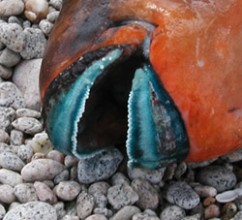
The parrot fish can’t metabolise this coral so it ‘throws it overboard’ in the form of grains. The existence of this species of fish is essential to the survival of the coral as it acts as a ‘natural cleaner’ of parasites, etc. that grow on it, so without the help of the parrot fish the coral would die. If you find yourself near one of these fish you will find them munching and making crunching sounds with every bite.

Another reason is that they need to do this constantly in order to keep their beaks clean and that they (the beaks) don’t grow too much. We’re talking about an insatiable fish that spends the whole day eating and ‘discharging’ without a break and that’s why just one parrot fish can produce 100 kg of white sand every year!! Thinking about this then, to those of us who adore paradisiacal beaches, it’s obviously important that there is an abundance of the parrot fish.
So next time time your laying on a white sand beach just think that sand came from a fish's bum haha only kidding only a small amount is produced this way.


No comments:
Post a Comment